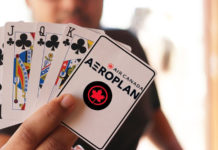NOTICE: This post references card features that have changed, expired, or are not currently available
In a recent post, Frugal Travel Guy said that he would no longer use his Citi Forward card at restaurants. Instead, he would go with his Chase Sapphire Preferred Card. He wrote:
I keep thinking about going back to the Grand Hyatt in Kauai. It has become our personal palace of refuge. I’m just too darn cheap to pay the $750+ per night for an oceanfront club room and Thank You points just don’t seem the way to go anymore. I’ll never earn Hyatt status by paying for rooms, have already been comped to Diamond one time and several mornings ago made the shift.
I replaced the Citi Forward card with a Chase Sapphire Preferred card. I value its 2 points per dollar on dining at almost 3 cents each when I can redeem them at the Grand Hyatt for 27K per night vs $750-plus-or-minus. And it just simplifies my life.
As background, at restaurants, the Citi Forward card gives 5 ThankYou points per dollar, whereas the Sapphire Preferred Card offers 2 Ultimate Rewards points per dollar. If you factor in the Sapphire Preferred Card’s 7% annual dividend, then it really offers a total of 2.14 points per dollar. As Frugal Travel Guy pointed out, Ultimate Rewards points can often be worth much more than a penny each when transferred to airline or hotel programs whereas ThankYou points are fixed to around 1 cent per point (depending upon how they are redeemed).
There’s no doubt that Frugal Travel Guy’s new approach is simpler. He can carry fewer cards in his wallet and always earn valuable Ultimate Rewards points. But if his primary goal is to stay at the Grand Hyatt in Kauai, is this the best use of his restaurant spend? The Forward card earns 5 points per dollar at restaurants and those points can be converted to Hyatt gift cards at a penny each. Wouldn’t that be a better option? Let’s dig into this question…
Rate research
At Hyatt hotels, if you pay with points, the rate is fixed by the hotel category. The Grand Hyatt Kauai is a top of the line category 6 hotel. As such, Hyatt charges 22,000 points per night for a base room, 27,000 points per night for a Grand Club room, or 33,000 points per night for a Suite.
Paid rates, though, vary tremendously depending on the dates of your stay. I looked at various potential stays in the coming months to see the usual rates. Not surprisingly, stays booked in November and December (before Christmas break) were significantly cheaper than during the high season: Christmas break through March. The following prices include taxes but not resort fees:
Pre Christmas Rates (November / December):
- Garden View: $328
- Partial Ocean View: $350
- Grand Club: $464
- Ocean Suite: $725
High season (Christmas break, through Spring Break):
- Garden View: $521 to $586
- Partial Ocean View: $643 to $708
- Grand Club: $891 to $956
- Ocean Suite: $1,397
Upgrades
In addition to using Hyatt points for free nights, points can also be used for room upgrades on paid stays. Hyatt charges only 3000 points to upgrade to a Grand Club room for up to 4 nights, and only 6000 points to upgrade to a Suite for up to 4 nights.
For a resort property like the Grand Hyatt Kauai, Hyatt has the following requirement for upgrades: “you must pay a minimum of the Hyatt Daily Rate deluxe room (such as partial ocean view, ocean view, slope view, etc).”
So, if your goal is a paid stay in a Grand Club room or a Suite, your best bet is to book a Partial Ocean View room and use points to upgrade (make sure upgrades are available, though!). As you can see above, Partial Ocean View room at the Grand Hyatt Kauai ranges in price from $350 to $708 for the dates I examined.
Fudging the math, just a little
One of the benefits of booking a paid stay instead of using points is that you will then earn Hyatt points for your stay. The basic earning rate is 5 points per dollar and up to 30% more for elite members. Rather than trying to account for the value of the earned Hyatt points here, I’m going to simply declare that the points earned can be used to replenish points spent for an upgrade. It only takes $600 of spend to earn enough points for a 4 night Grand Club upgrade, or $1200 of spend for a 4 night Suite upgrade. So, usually, you will earn more than enough Hyatt points to replenish those used for an upgrade.
Grand Club room
To stay in a Grand Club room, the best options are to pay with points for 27,000 points per night, or to book a paid stay in a Partial Ocean View room and upgrade to a Club room with points. Which is better?
In low season, if you spend 27,000 points rather than paying $350, you will get only 1.3 cents per point in value. At the top of high season, though, if you spend 27,000 points rather than paying $708, you will get 2.6 cents per point in value.
Suite
To stay in a Suite, the best options are to pay with points for 33,000 points per night, or to book a paid stay in a Partial Ocean View room and upgrade to a Suite with points. In low season, if you spend 33,000 points rather than paying $350, you will get a paltry 1.1 cents per point in value. And, at the top of high season, if you spend 33,000 points rather than paying $708, you will get 2.1 cents per point in value.
Chase Sapphire Preferred Card vs. Citi Forward
The question we started with is which card is better for restaurant spend if your goal is a luxury stay at the Grand Hyatt Kauai? Since the Sapphire Preferred Card earns 2.14 points per dollar whereas the Citi Forward earns 5 points per dollar, we can calculate that the Citi Forward card earns 2.3 times as many points as the Chase card. And, since each Citi ThankYou point is worth exactly 1 cent towards a paid Hyatt stay, you would have to get at least 2.3 cents value from each of your Chase Ultimate Rewards points to argue that the Sapphire Preferred Card is the better option for dining.
As I showed above, when using points for a Grand Club room stay, you can expect to get between 1.3 and 2.6 cents per point in value. So, it is only in the high season that you’ll do better with Ultimate Rewards points. With a Suite, it looks like you’ll always do better with the Citi Forward card since my calculated point values ranged from 1.1 cents to 2.1 cents.
An example
Let’s say that, over time, you spend $14,000 in restaurants. If you used the Citi Forward card, you would earn 70,000 ThankYou points which would be just enough to book a $700 night at this Hyatt in high season, or two nights at this Hyatt in low season. You could then use Hyatt points that you’ve earned from previous stays (or wherever) to upgrade to a Grand Club room or to a Suite (depending upon availability). If, instead, you spend all $14K with the Chase Sapphire Preferred Card, you would earn just shy of 30,000 Ultimate Rewards points. This would be enough for one night in a Grand Club room and just shy of enough for one night in a Suite, regardless of current room rates.
So, as you can see, earning 5X ThankYou points gives you approximately the same Hyatt stay potential as the Sapphire Preferred Card for high season nights, but it gives you significantly more stay potential for low season nights.
Pursuing status
Frugal Travel Guy specifically said that he wasn’t pursuing Hyatt elite status, so this isn’t a factor for him, but it may be important to you. If you are interested in earning Hyatt elite status through stays, then using the Forward card has the added benefit that paid stays count towards elite status.
Beyond Forward, dining, and Kauai
The scenario presented above asks a very specific question: which card is better for use at restaurants if the goal is a free night at the Grand Hyatt Kauai? The answer is that the Forward card is at least as good as the Sapphire Preferred Card, but often a better choice. It’s important to note, though, that this analysis ignores many important details:
- The Citi Forward card charges foreign transaction fees, so it is not a good idea to use it outside of the US.
- The analysis doesn’t take into account your existing point balances or earnings outside of dining. If you are already earning Ultimate Rewards points in other ways, then it makes complete sense to use your card at restaurants to bump up your point balance to get enough for your next award.
- At pricier Hyatt hotels, the same analysis would tip in favor of the Sapphire Preferred Card.
- Ultimate Reward points have many more valuable options than just Hyatt stays. You may find that you can often get more than 2.3 cents per dollar with those points, so for many people it absolutely makes sense to prefer the Sapphire Preferred Card over the Forward card.
- There are a few other cards with decent restaurant category bonuses. In particular, it’s worth considering the US Bank Cash+ card where you can pick Restaurants as one of your 5% cash back categories. This 5% rate, though, is limited to $2000 in spend per quarter. Also, unlike the Citi and Chase cards, US Bank differentiates between Restaurants and Fast Food so you may have to pick both categories to ensure that you’re covered. You can find other cards with good bonuses here: Best Category Bonuses.






Greg: Thanks (I think), but I gave up academia many years ago and have been much happier for it 🙂
FM, I think you should find a researcher/scientist job in academia or research labs..
Your analysis shows why I’m loyal to my Citi Forward card. Now if only I could remember to have my Sapphire with me on First Fridays for 3X at dining.
Please do not mention the FTG in your posts. Why?
1. He’s a liar.
2. Pushes his affiliate links with poor advice and half-truths.
3. Will sue anyone or anything for any reason (eg. United Airlines).
4. He’s ignorant.
Sorry about misunderstanding.
Thanks for clarification.
Thanks for the analysis.
Just one more question, is it true that the stays at Hyatt booked with Thankyou Points count towards Elite Qualification?
I only know the reservations from Hyatt.com and AMEX Fine Hotels&Resorts count towards elite qualification.
Yi: I am not advocating booking Hyatt stays with ThankYou points. Instead, I was saying that you can redeem ThankYou points for Hyatt gift cards at 1 cent value per point. Then book directly via Hyatt
[…] What’s the Best Credit Card for Restaurants and Eating Your Way to a Free Trip? […]
Oh sorry misread your post. But it’s probably useful info anyway for those who want to use TY points in general for hotel stays. I also noticed airline prices are frequently inflated by the TY portal relative to the going rate. As soon as the 5x promo is done I’m dumping the card. The best use is bestbuy certificates so I can buy a new laptop and tv.
So what’s your prognosis for DeltaPoints who is convinced that using UR points like TP at 1.25 cents is a good deal because it saves him cash out of pocket?
DBest: I don’t like to use UR points that way because I’d much rather keep them for high value airline or hotel redemptions, but there are some situations where it makes sense for some people.
Not so fast chief, thank you points are worth 1 cent in theory. In practice the portal used to book hotels often shows a higher underlying price than what is otherwise publicly available from the hotel or websites like hotels.com. I’ve run into this problem many times. Usually worst case scenario is 80% return on TY points.
Frequent Churner: I guess I wasn’t clear in my post. I am NOT advocating booking Hyatt stays with ThankYou points. Instead, I was saying that you can redeem ThankYou points for Hyatt gift cards at 1 cent value per point.
i dont think you get hyatt pts and elite acess if you book through your Citi TY points…?
Robbie: That’s right, you shouldn’t book through ThankYou. The idea here is to redeem ThankYou points for Hyatt gift cards, then book directly and use the gift cards to pay at the hotel. I wasn’t saying that this is the very best use of ThankYou points, just showing that you can get good value with 5X ThankYou points when compared to 2X Ultimate Rewards.
I am a bit confused the cost listed for suites/Grand Club don’t line up with the costs used in your analysis.
Boon: In the section titled “Upgrades” I suggested that the best paid option for Club rooms or Suites is to book a Partial Ocean View room and use points to upgrade. The points you earn from your stay will be enough to refund the points used for the upgrade so I don’t count those points as an additional cost.
Greg, great analysis and I came to the same conclusion that I need to use ur for our high season stays.
And thanks for the low season ideas. Time to rethink those it looks like
Thanks again
Rick
If he truly is frugal he’s probably not spending about $270/week at restaurants. Neat analysis though, math can easily be changed to suit your own #s
Gary: Yes, true. I tried to add a similar caveat in the second bullet at the end of the post.
.
Josh F: Thanks. Yes, I picked that particular amount of spend in my example so that I could get at least one free night with either program.
.
Rick I: Thanks.
Good analysis but one wrinkle is assumption of earning all points for the stay via one card or the other, and via category bonus spend.
Hyatt gift cards would be valuable on a Hyatt stay to cover incidental expense. But for the room itself, points and gift cards aren’t combinable (points from other sources and Chase points are combinable, cash and gift cards are combinable).
For most the relevant decision-making will happen at the margin, not earning all points from restaurant spend on one card or the other.
And points that push you over the top for an award are worth more because they make the rest of the points worthwhile. (By the same token, excess points are worth less.)
If you have 20,000 points, then 2000 Chase points transferred to Hyatt are worth more than a small number of Thank You points.
Comes down to your volume of restaurant spend, if you do enough to buy sufficient gift cards outright, then your analysis holds. If you are using restaurant spend as a supplement to top off a Gold Passport account, analysis likely tips the other way.
Decisions are usually made at the margin.